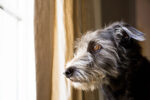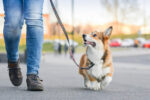If your dog is rifling through the garbage, ripping up pillows, and urinating or defecting indoors, they’re most likely suffering from separation anxiety. Whenever you are not around your dog, they experience high levels of mental and/or emotional stress, as they are detached from you, hence “separation anxiety.” The most usual culprits of separation anxiety is using the bathroom in doors (if they are house-trained), chewing up furniture and clothing, digging at carpet or hard floors, and trying to break down windows and doors to escape, or straight up escaping through open doors and windows in an attempt to run away. Schedule a veterinarian appointment to make sure there isn’t a larger medical issue with your dog that has been lingering unidentified. Once you know their behavior is based off their separation anxiety, there are three things you can do.
Plenty of Physical Exertion Before You Leave
You never want to leave a dog without tiring them out. If they have too much potential energy, this will turn into anxious kinetic energy, and you won’t like what you return to. If you can run, walk, or play with your dog before you leave, they are less likely to feel anxious while you’re away. If you’re lucky, they may end up just sleeping while the stimulation of the owner is not there. You’re part of your dog’s pack, and when you’re around, depending on the breed, they may feel more or less inclined to have to be present and alert to protect you. If you have a secure attachment with your dog, they will most likely just sleep while you’re gone as they will be thoroughly worn out from the run, walk, or play time you gave them before you left. You don’t want to leave immediately after you work them, as they will still be wound-up from the excitement. Be sure to give your dog at least thirty minutes to wind-down before you leave them.
Composed Exits and Calm Entries
People tend to make dramatic exits when they have to leave their dog which only adds to the dog’s separation anxiety. Dog’s feed greatly off the alpha’s energy. In this case, you are the alpha, as you are the one that feeds and provides for them. If you exit calmly, you dog will see that there is no reason to be excited, and their excitement won’t turn into anxiety when you leave the house. Likewise, when you return, you can give them love and attention calmly so they understand this a normal occurrence and will continue to happen. Never give a rambunctious dog jumping all over you love and attention, this will reinforce unwanted behavior. Instead, use a commanding (clear, deep) tone and tell them “down.” Once your dog stops jumping on you, you can begin to pet them and show affection. This will teach them that you do not want them jumping on you or others and likewise reinforce the idea that coming and going is a regular part of life they will need to get used to.
Give Your Dog a Treat When You Leave
Everyone loves a treat, especially your dog. When you leave, give them a little treat or a bone so they have something to do. Likewise, when you give your dog a treat when you leave, they will look forward to you leaving opposed to dreading it. If you give them a toy or a substantial treat, like a bone, this will give them something to work on and distract them from the fact you aren’t around. “Busy toys,” more commonly referred to as puzzle toys, or also a great idea to make your dog work for the treat. More importantly, it will take more time for them to get to the treat or treats, depending on the toy, extending the amount of time it takes for them to realize you aren’t there. If you don’t have the means to purchase several puzzle toys for your dog, you can spread peanut butter inside one of their favorite bones. The peanut butter-in-a-bone method works best for apartments with hard floors throughout, as any carpets have the potential to be ruined by the peanut butter.





